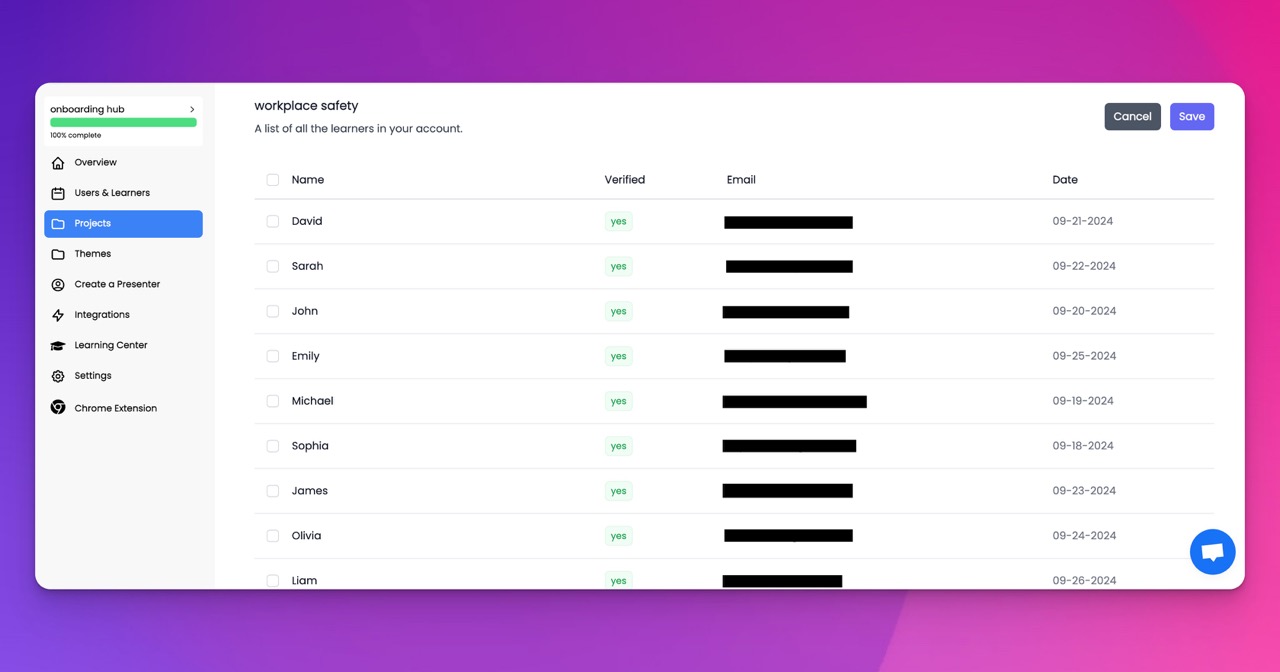🎉 Trainday now integrates with Zendesk and Hubspot 🎉 Trainday now integrates with Zendesk and Hubspot 🎉 Trainday now integrates with Zendesk and Hubspot
🎉 Trainday now integrates with Zendesk and Hubspot
🎉 Trainday now integrates with Zendesk and Hubspot
Contact
Smart Training for Accessible Workplaces - AI and Data in ADA Compliance
The Basics of ADA Compliance
The ADA prohibits discrimination against individuals with disabilities and mandates reasonable accommodations in the workplace, public spaces, and beyond. ADA compliance training is critical for helping employees and managers understand their roles in creating an accessible environment. It encompasses a wide range of topics, from physical accessibility requirements to digital accessibility and reasonable accommodations for various disabilities.
While ADA compliance training is essential, traditional approaches can be limited by several factors:
Complex regulations: ADA guidelines are extensive, covering a broad spectrum of accommodations and accessibility considerations.
Different needs for different roles: Employees across departments have unique responsibilities when it comes to ADA compliance, which means training needs to be specific and relevant.
Continuous updates: Accessibility standards evolve as new tools and technologies emerge, requiring constant adjustments to training content.
Low engagement in traditional training: Compliance training is often viewed as a dry, technical obligation, which can lead to low engagement and retention.
AI and data-driven solutions are transforming ADA compliance training, making it a more engaging, adaptive, and impactful experience that fosters accessibility and inclusion.
How AI and Data Elevate ADA Compliance Training
1. Tailored Learning Paths for Specific Roles
AI can analyze employees’ roles and responsibilities, creating custom training paths that focus on the ADA aspects most relevant to each position. For example, an IT specialist might focus on digital accessibility practices, while a facilities manager would need to know about physical accessibility features.
By delivering personalized, relevant training, AI-driven platforms ensure employees receive targeted education that directly applies to their roles. This tailored approach boosts understanding and engagement, making ADA training a more meaningful experience.
2. Real-Time Updates for Regulatory Changes
ADA compliance standards and best practices evolve over time, especially as new accessibility technologies emerge. AI-powered platforms automatically track and integrate changes in ADA guidelines into training modules, ensuring employees always receive the latest information.
For example, if digital accessibility standards are updated, an AI-driven platform can incorporate those updates into training content for web developers and designers. This real-time adaptation ensures continuous compliance without the need for constant manual updates, allowing organizations to stay ahead of regulatory changes with minimal effort.
3. Engaging and Interactive Learning Experiences
Traditional ADA training can sometimes feel like a “checkbox” exercise, but AI can transform it into an engaging, immersive experience. AI-powered platforms incorporate interactive elements like simulations, quizzes, and case studies to bring ADA concepts to life.
For instance, an AI-driven platform could use simulations that let employees experience common accessibility barriers, helping them understand the challenges faced by people with disabilities. This interactive approach enhances retention, empathy, and engagement, leading to a more informed and accessibility-conscious workforce.
4. Predictive Analytics for Proactive Accessibility
Data-driven insights allow companies to identify areas where accessibility improvements are needed before they become compliance issues. By analyzing data on workplace incidents, employee feedback, and training assessments, AI can predict and recommend solutions to potential accessibility challenges.
For example, if data reveals a pattern of digital accessibility issues in a company’s online platforms, AI can flag this for the organization and suggest further training for the digital team. This proactive approach minimizes ADA compliance risks and promotes a culture of continuous improvement.
5. Automated Tracking and Reporting for Compliance
Maintaining accurate records of ADA training completion and compliance is essential for organizations, especially if an audit arises. AI simplifies this process by automatically tracking employee progress and generating detailed reports on ADA training completion, certifications, and knowledge assessments.
AI-powered platforms can also send automated reminders to employees about training deadlines, helping organizations ensure compliance without constant oversight. With detailed tracking, organizations can quickly demonstrate their ADA compliance efforts and commitment to accessibility.
Benefits of Smart ADA Compliance Training
1. Increased Awareness and Inclusivity
By making ADA training engaging and interactive, AI-driven platforms help employees develop a deeper understanding of accessibility and its importance. This fosters an inclusive workplace culture where everyone understands their role in supporting accessibility.
2. Improved Efficiency and Relevance
Automating ADA compliance training with AI saves time and resources by delivering targeted, role-specific content. Employees receive training tailored to their needs, eliminating unnecessary information and allowing them to focus on relevant ADA requirements.
3. Enhanced Employee Engagement and Retention
Interactive elements like quizzes, simulations, and real-world scenarios make ADA compliance training more engaging. Employees are more likely to retain the information when they are actively involved in the learning process, leading to better understanding and application of ADA principles.
4. Proactive Accessibility and Risk Management
Data analytics and predictive insights help organizations identify and address accessibility gaps before they escalate into compliance issues. This proactive approach allows companies to create safer, more inclusive workplaces while minimizing the risk of ADA violations.
5. Simplified Documentation and Reporting
AI-powered platforms automate tracking and reporting, making ADA compliance documentation easy and efficient. Detailed reports allow organizations to demonstrate compliance efforts and meet regulatory requirements with confidence.
Embracing AI-Driven ADA Compliance with Trainday
Platforms like Trainday leverage AI to create ADA compliance training that goes beyond the basics. Trainday offers:
Customized training paths tailored to each role, ensuring relevance and boosting engagement.
Automatic updates that integrate real-time changes to ADA standards.
Interactive simulations and case studies that foster a deeper understanding of accessibility.
Predictive analytics to proactively manage potential accessibility challenges.
Automated tracking and reporting to simplify compliance management.
With Trainday, organizations can take a smart, data-driven approach to ADA compliance, building not only awareness but also a lasting culture of accessibility and inclusion.
Accelerate Compliance.
Deliver OSHA-Ready Courses Instantly.
Empower your team with data-driven training solutions tailored to your industry's safety standards. Stay compliant, reduce risks, and boost productivity with AI-powered course creation.
